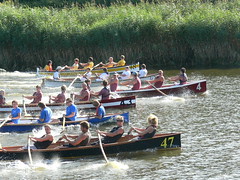The
Gokstad ship with her upswept ends is one of the world's icons. She still has an air of speed and menace that sends a thrill down the spine, giving some inkling of the effect she must have had on plump city folk round the coastline of Europe from Colchester to Constantinople.

Less well known are the boats such as this one that were found inside the Gokstad burial, but they have the same characteristic shape and just the same type of construction.
I've always hankered after a Viking style boat. Not a 'reconstruction using authentic tools', with all the accompanying leaks, mess and need to share the boat with hairy Viking re-enactor types who can bore you to Valhalla and back about 10th century battle-axe technique. No, what I want is a boat with the upturned ends that is easy to row single handed and has lots of room inside for camp cruising. A small rig for downwind, an oar to steer her by, and a Viking boat would be the ideal weekender.

Which is exactly what Canadian boatbuilder Mark Wallace has achieved. His
Gokstad Skiff is an attempt to recreate the boat using modern glued lapstrake or clinker plywood. It is smaller than the original at only 14ft long by 4ft 2in beam, and has a flat bottom for easy beaching. If she is trimmed down slightly by the bow when rowing into the wind, she can be made to 'weathercock' - the raised stern catches the wind and automatically keeps you on track.
Mark reports that she is a delight to row, and has been used for cruises around the islands of the west coast where he lives.

He is not so pleased with the appearence, however, and feels that the beautiful feel of the original was not carried over into the skiff. That, I suspect, is a matter of opinion. He also thinks that a bit of extra length, perhaps 16ft, would improve performance.
I would love to build the larger version, perhaps even stretching it to 18ft with a 5ft beam, to swing a beefy pair of oars. Add a small standing lug for downwind, and you could really go places. A lot of fun, even though sack, rape and pillage are no longer absolutely legal in these degenerate days.
Unfortunately, Mark has no time and I have no money, so the project is on hold for a while. But it is definitely at the back of my mind, festering. One day....
(Thanks to Mark for the pictures).
 Vicky's boats, the Heritage range made by Little River Marine in Florida, are traditionally styled skiffs in modern materials, and seem ideal for fun rowing. The picture shows the Heritage 12, with a guy doing something you can't do in a shell! Though I am sure that if a club bought two of them, they would start racing before the first day was out....
Vicky's boats, the Heritage range made by Little River Marine in Florida, are traditionally styled skiffs in modern materials, and seem ideal for fun rowing. The picture shows the Heritage 12, with a guy doing something you can't do in a shell! Though I am sure that if a club bought two of them, they would start racing before the first day was out....


























